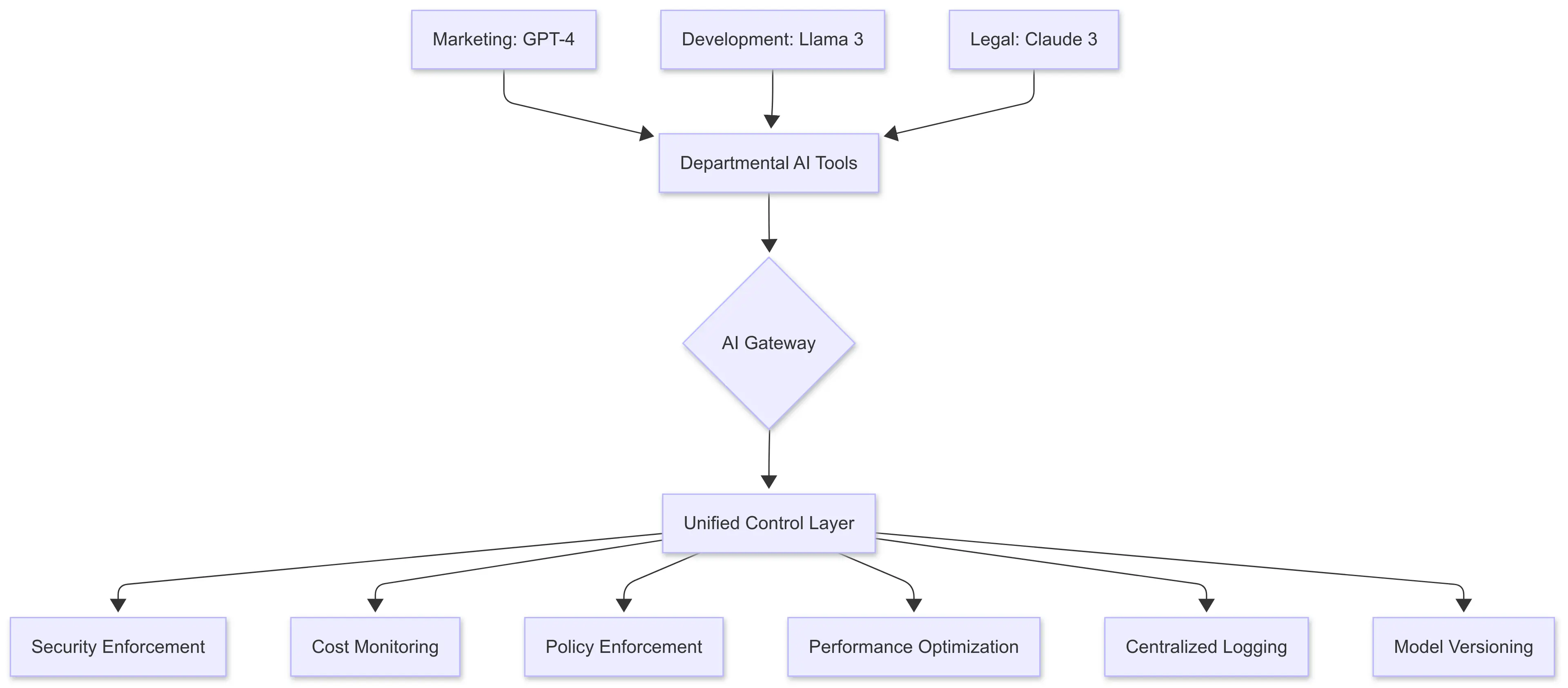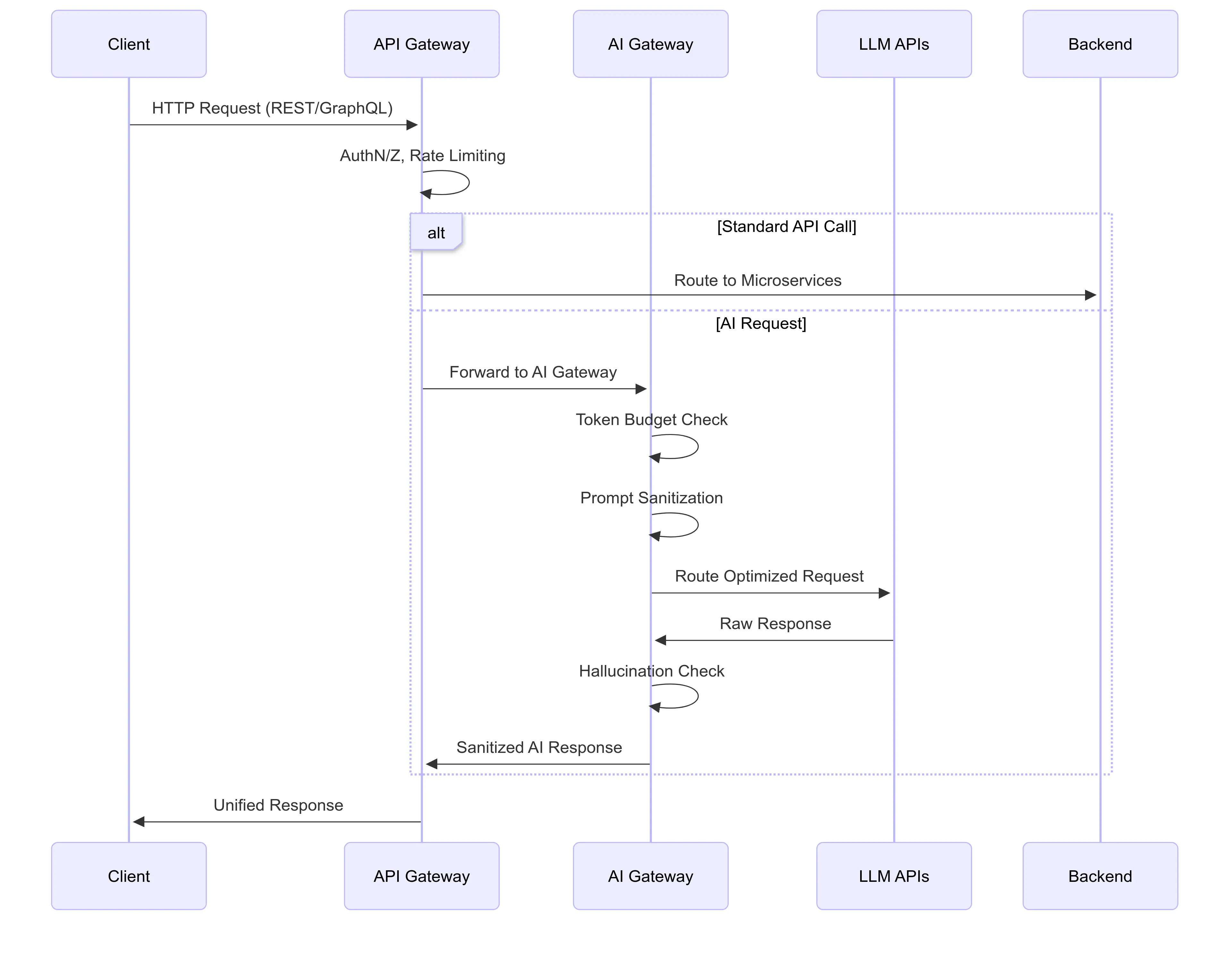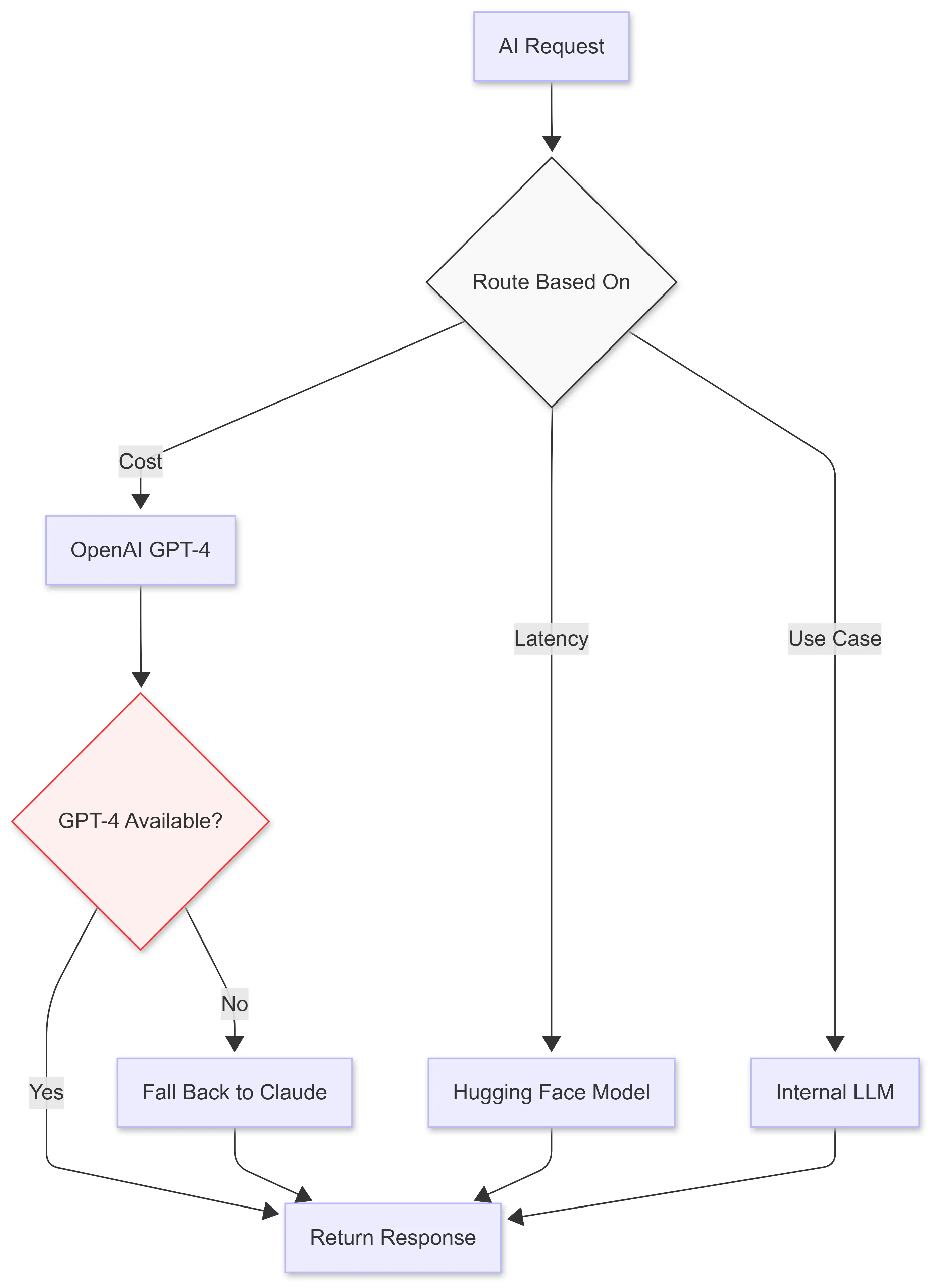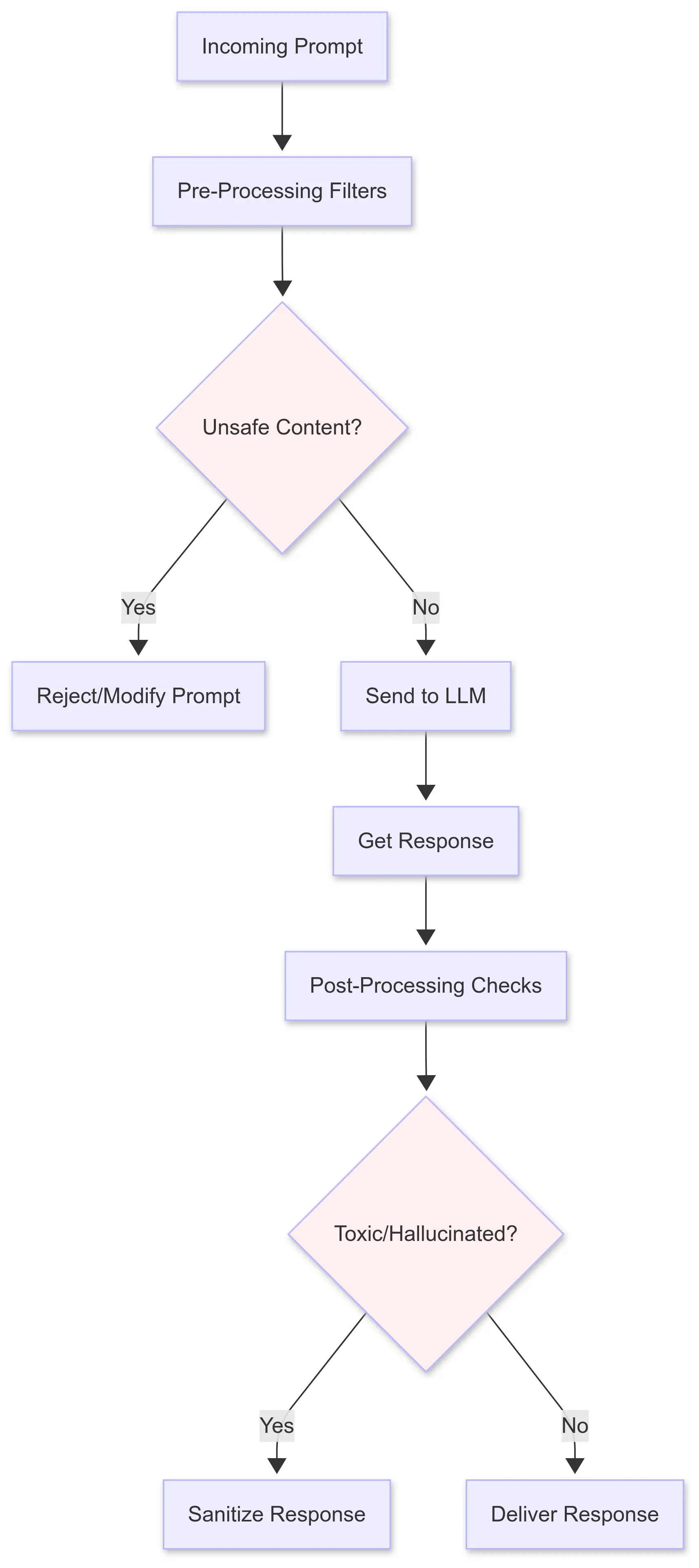Discover how AI gateways are revolutionizing enterprise AI infrastructure, offering centralized control, security, cost management, and governance for AI models and services.
AI Infrastructure Revolution
The enterprise AI landscape has exploded into fragmented chaos. Marketing teams deploy GPT-4 for content generation, developers fine-tune Llama 3 for coding assistants, while legal departments rely on Claude 3 for contract analysis. This siloed adoption creates three critical pain points:
- Security Vulnerabilities: 68% of enterprises report unauthorized AI tool usage leading to PII leaks (Gartner 2025)
- Cost Overruns: Unmonitored token consumption causes 41% of companies to exceed AI budgets by 200%+ (McKinsey)
- Governance Failure: 83% of compliance violations trace to inconsistent AI policy enforcement (Deloitte Audit Report)
Enter AI gateways—the middleware revolution transforming enterprise AI from experimental tools to production-grade infrastructure. These systems consolidate fragmented AI interactions through a unified control layer, much like Kubernetes did for container orchestration. An AI gateway is a specialized middleware layer that manages and secures interactions between your applications and AI models, such as OpenAI's offerings. This technology, akin to an API gateway, provides visibility and control over your AI applications. The future of AI infrastructure is increasingly modular, enabling flexible and robust machine learning teams.
What Is an AI Gateway
An AI gateway is a middleware platform designed to manage and facilitate the integration and deployment of artificial intelligence models and services, such as OpenAI, Anthropic, Gemini, etc. It acts as a bridge between AI models and the applications that use them, simplifying integration and deployment, especially for large language models. Essentially, an AI gateway serves as a crucial control point for managing AI services within an organization. It also plays a vital role in security by inspecting inbound prompts and outbound responses to prevent data leaks and mitigate risks within the AI application workflow.

AI Gateway vs API Gateway: Critical Differences
While AI gateways and API gateways share some infrastructure-level similarities, they differ significantly in purpose, functionality, and optimization.
| Feature | AI Gateway | API Gateway |
|---|---|---|
| Primary Use Case | Managing, securing, and optimizing traffic to AI/LLM services (e.g., OpenAI, Anthropic, custom models) | Routing and securing general-purpose REST/gRPC APIs for web, mobile, and microservices |
| Request Characteristics | Often large payloads (e.g., prompts), streaming input/output, expensive per-call | Lightweight, transactional HTTP/gRPC requests |
| Cost Awareness | Tracks tokens, usage costs, and budget limits per user/app | Generally unaware of downstream compute or pricing costs |
| Observability Needs | Input/output tracing, latency + token logging, hallucination detection | Standard request logs, metrics (latency, throughput, error rate) |
| Security Features | PII redaction, prompt inspection, AI-specific abuse filters | OAuth, JWT, IP allowlists, rate limiting |
| Optimization Techniques | Caching AI responses, model fallback, prompt standardization, and dynamic routing by cost or latency | Load balancing, circuit breaking, and service discovery |
| Plugin Support | AI-specific (e.g., pre-/post-processing, moderation, reranking) | General plugins (e.g., auth, logging, CORS) |
| Streaming Support | Critical: supports real-time token streaming from LLMs | Optional: typically used for HTTP/2 or WebSocket |
| Governance Controls | Usage quotas, cost controls, and team-level restrictions for AI services | API-level access controls, usage policies per role/team |
| Integration Targets | LLM APIs (e.g., OpenAI, Anthropic, local models like Llama), AI agents, RAG systems | Microservices, internal APIs, public-facing APIs |
Summary of Key Distinctions:
- Focus: AI gateways specialize in intelligent traffic management for AI models, while AI gateways focus on standard API traffic orchestration.
- Observability: AI gateways require fine-grained monitoring, including cost and token-level visibility.
- Security: AI gateways offer general web security, whereas AI gateways need content-level protections (e.g., for prompt injection).
- Optimization: AI gateways can route based on AI-specific metrics (e.g., model latency, accuracy, cost), unlike traditional AI gateways.

Why AI Gateways Are Essential for Enterprises?
In a world where AI adoption is accelerating, AI gateways offer a critical layer of control, visibility, and governance. They enable enterprises to confidently integrate AI into their systems securely, scalably, and sustainably.
You need an AI gateway when:
- You're using LLMs or AI APIs in production (e.g., OpenAI, Claude, Gemini).
- You want centralized governance and cost control over AI usage.
- You need security and content moderation for AI prompts/responses.
- You must support multiple models with fallback or dynamic routing.
Here's a breakdown of why AI gateways are crucial for modern enterprises:
1. Centralized Control for AI Services
Enterprises today adopt multiple AI models (e.g., OpenAI, Hugging Face, internal LLMs) across cloud and on-prem environments. An AI gateway provides:
- Routing logic based on cost, latency, or use case.
- Model versioning to avoid breaking downstream systems.
- Fallback mechanisms (e.g., if GPT-4 fails, fall back to Claude).

2. Security and Compliance
AI gateways serve as security enforcement layers:
- Rate limiting and quota management to control the usage of costly LLM APIs.
- Authentication & Authorization for internal and external consumers.
- PII masking and data redaction to ensure data privacy before reaching LLMs.
- Audit logs to support compliance (e.g., GDPR, SOC 2).
3. Observability and Monitoring
Visibility is critical when running generative AI workloads:
- Logging inputs/outputs and response times for debugging.
- Tracing to understand latency bottlenecks.
- Monitoring token usage and cost for budget optimization.
4. Performance Optimization
AI gateways can significantly improve efficiency:
- Caching responses to avoid redundant LLM calls.
- Load balancing across multiple AI model endpoints.
- Streaming support for faster UX in chat applications.
5. Cost Control and Governance
With AI APIs costing per-token or per-call, an AI gateway enables:
- Usage policies per team or app to prevent budget overages.
- Token counting and cost attribution for internal chargebacks.
- Auto-throttling or alerting based on budget thresholds.
6. Flexibility for Hybrid/Multi-Cloud AI
AI workloads are often hybrid (cloud + on-prem) or multi-cloud. An AI gateway:
- Supports traffic routing across environments.
- Helps abstract away vendor-specific endpoints.
- Allows easy swapping of model providers without rewriting client code.
7. Plugin Ecosystem for AI Use Cases
Advanced AI gateways support plugins for:
- Prompt templating and standardization
- Content moderation (e.g., toxicity detection)
- Custom pre- and post-processing
Trends Shaping AI Gateways
Here's a comprehensive look at the trends shaping AI gateways in 2025 and beyond, driven by advancements in large language models (LLMs), multi-model architectures, enterprise governance demands, and the need for scalable, secure AI infrastructure.
1. Multi-Model Routing and Federation
Modern AI apps increasingly call multiple models—OpenAI for coding, Claude for summarization, open-source LLMs for privacy.
- AI gateways are evolving to support multi-model orchestration: routing requests based on latency, accuracy, cost, or trust.
- Federated AI inference across local, edge, and cloud-hosted models is becoming common.
2. Token-Aware Cost Governance
Cost-first LLMOps with budget capping and per-call spend limits. LLM APIs are priced by token, making cost tracking critical.
- AI gateways now include token accounting, quota enforcement, and cost attribution per user/team.
- Enterprises want real-time dashboards and budget guardrails to avoid unexpected bills.
3. Prompt and Output Moderation Pipelines
Built-in security layers are becoming standard for enterprise-grade LLM access. Prompt injection, jailbreaks, and hallucinations are real risks.
- AI gateways increasingly support pre-processing filters (for prompt safety) and post-processing checks (for toxic/hallucinated content).
- Expect pluggable moderation, e.g., connecting to third-party content filters or in-house classifiers.

4. LLMOps Integration
Gateways now help manage deployment lifecycle, usage policies, and routing across model updates. AI gateways are becoming key components of the LLMOps stack, sitting between orchestrators, vector stores, and foundation models.
- Seamless integration with vector databases, RAG pipelines, fine-tuning services, and agent frameworks.
- Unified config and telemetry across dev/test/prod environments.
5. Hybrid and Multi-Cloud AI Infrastructure
A gateway becomes the unifying control plane in a fragmented AI ecosystem. AI workloads are distributed across SaaS APIs, private clusters, edge devices, and cloud VMs.
- AI gateways act as cross-environment brokers, abstracting model locations and offering location-aware routing.
- They ensure policy compliance and telemetry collection across all inference points.
6. Open Standards and Ecosystem Interoperability
The ecosystem is trending toward vendor-agnostic, modular AI infrastructure. Avoiding lock-in is a top concern.
- Movement toward standardized APIs (e.g., OpenLLM, OpenAI-compatible APIs).
- Gateways support pluggable backends, open telemetry, and policy engines.
Conclusion: The Strategic Imperative
AI gateways are security enforcers, policy engines, observability hubs, and optimization layers for enterprise AI. As AI adoption deepens, the gateway becomes the enterprise's trust boundary for AI. Enterprises implementing them now gain: risk reduction, cost control, and velocity acceleration.
As Anthropic CEO Dario Amodei notes: "The next AI competitive advantage won't come from larger models, but from smarter orchestration."* Organizations delaying adoption face irreversible technical debt, while early adopters already attribute revenue growth to AI gateway-optimized personalization systems.
The future is clear: AI gateways are becoming the central nervous system of intelligent enterprises. Those who architect this layer today will dominate the AI-driven economy of tomorrow.
